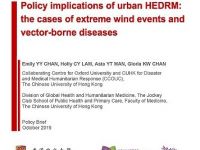Natural hazards have direct and indirect health impacts. Apart from physical and mental trauma, other health impacts include malnutrition, disrupted disease treatment plans, and risk of infectious diseases. Health impacts may be mitigated through health-related emergency and disaster risk management (Health-EDRM). They are systematic analysis and management of health risks through the reduction of hazards and vulnerability in all stages of the disaster management cycle, from prevention/mitigation, preparedness, response to recovery (Lo et al., 2017; World Health Organization [WHO], 2019).
Read MoreYou are here
Article(s) related to "policybriefs"
2019
2018
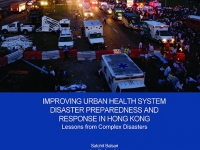
The increasing frequency of natural disasters around the world has been accompanied by concomitant, growing sophistication in disaster planning and response. In recent years, incident command systems, mass casualty trainings, triage protocols, inter-agency communication strategies, along with backup systems for power, personnel, and equipment have all seen an exponential growth in competence and understanding
Read More2017
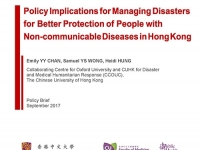
Between 2005 and 2014, disasters have caused total damage of US$1.4 trillion worldwide, with 1.7 billion people affected and 0.7 million killed [1]. With climate change, urbanization, environmental degradation and poverty, the world has been experiencing disasters at a higher frequency and intensity. To be effective, disaster management strategy must be able to meet the health needs of the affected population. With non-communicable diseases (NCDs) now being the major disease burden and leading causes of death worldwide, the traditional health focus of humanitarian response on acute conditions is no longer sufficient to address population health needs in disaster and emergency context. The significance of NCDs management and planning for potential humanitarian context must be recognized.
Read More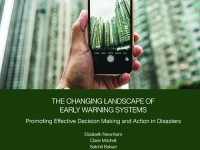
Early warning systems are critical to protecting populations from harm during disasters. The recent Sendai Framework for Disaster Risk Reduction highlights a need to increase the availability of and access to early warning systems as a priority target.1 A number of nations, including Hong Kong, have already established highly developed early warning systems. However, the changing landscape of communication technologies has created both opportunities and challenges for people as they navigate a greater number of information networks, and a higher frequency of messaging.
Read More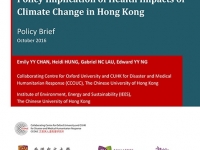
Climate change is one of the main global environmental changes the world is experiencing in the 21st century. Urban communities are vulnerable to climate impacts due to the high density of living arrangements and heavy reliance on life-line infrastructures for basic survival needs. This policy brief examines and discusses the human health impacts of climate change in Hong Kong, and presents key recommendations to support resilience building for the health challenges posed by climate change for the decades to come.
Read More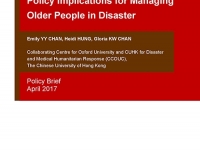
Between 2005 and 2014, disasters have caused total damage of US$1.4 trillion worldwide, with 1.7 billion people affected and 0.7 million killed. With climate change, urbanization, environmental degradation and poverty, the world has been experiencing disasters at a higher frequency and intensity. At the same time, global population is ageing at an unprecedented speed: between 2015 and 2030, the number of persons aged 60 years or over in the world is projected to grow by 56%, from 901 million to more than 1.4 billion. Older people therefore is going to be an increasingly important group, in terms of both their contribution and vulnerabilities, in the face of disasters. This paper discusses the disaster-related health risks of the older people in Hong Kong, and presents key policy recommendations for better protection of this vulnerable group.
Read More2016
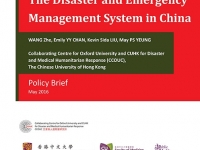
The SARS epidemic in 2003 was the trigger leading to a reform of China’s emergency management system. In 2007, the Chinese government adopted and enacted the “Emergency Response Law of the People's Republic of China”. The purpose of this law is to prevent and reduce the occurrence of emergencies, control, mitigate and eliminate the serious social harm caused by emergencies, regulating activities in response to emergencies, protecting the lives and property of the people, and maintaining national security, public security, environmental safety and public order. Following the restructuring of the emergency management system, the public health emergency management system has consequently undergone a significant change.
Read More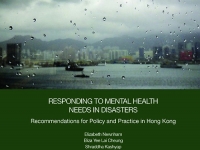
This policy brief is a part of the related research of the HKJCDPRI 5-year project. It outlines the existing emergency and disaster response system, a 3-tier system currently operating in the Hong Kong Special Administrative Region (HKSAR). Despite past epidemics, there remains a low level of community awareness, participation in basic first aid training and emergency preparedness.
The authors present recommendations which target to strengthen the response systems, to develop a competent and knowledgeable workforce, and to reduce the loss and suffering that occur during unexpected disasters. Engaging relevant stakeholders in contingency planning and equipping them with knowledge and skills on disaster preparedness; providing accessible information; organising drills and integrating
Read More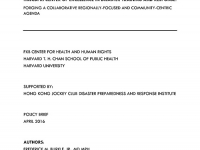
The Hong Kong Jockey Club Disaster Preparedness & Response Institute (HKJCDPRI), launched in 2014, is focused on establishing an evidence base in support of “effective disaster preparedness and response, both for Hong Kong and the Asia Pacific region.” This policy brief proposes a detailed agenda for the HKJCDPRI Center of Excellence in Disaster Preparedness and Response. Acknowledging the growing global shift from top-down emergency response systems to contextualized community-specific approaches, and the WHO-led coordination and standardization of Emergency Medical Teams, this brief outlines a research and training agenda that prioritizes community resilience.
Read More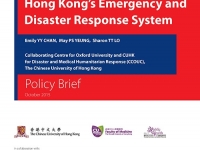
This policy brief is a part of the related research of the HKJCDPRI 5-year project. It outlines the existing emergency and disaster response system, a 3-tier system currently operating in the Hong Kong Special Administrative Region (HKSAR). Despite past epidemics, there remains a low level of community awareness, participation in basic first aid training and emergency preparedness.
The authors present recommendations which target to strengthen the response systems, to develop a competent and knowledgeable workforce, and to reduce the loss and suffering that occur during unexpected disasters. Engaging
Read More



